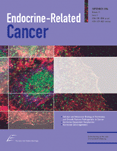| HOME | HELP | FEEDBACK | SUBSCRIPTIONS | ARCHIVE | SEARCH | TABLE OF CONTENTS |
|
|
||||||||
| ||||||||||||||||||||||||||||||||||||||||||||||||||||||||||||||||
Department of Endocrinology, Radboud University Nijmegen Medical Centre, PO Box 9101, 6500 HB Nijmegen, The Netherlands
1 Assistance Publique-Hôpitaux de Paris, Hôpital Européen Georges Pompidou, Service de Génétique, 20 rue Leblanc, 75015 Paris, France
2 Université Paris Descartes, F-75005 Paris, France
3 INSERM, U772, Collège de France, Paris, France
4 Endocrinology Unit, Department of Clinical Physiopathology, University of Florence, Via Pieraccini 5, 50139 Florence, Italy
5 Reproductive and Adult Endocrinology Program, National Institutes of Child Health and Human Development, National Institutes of Health, 10 Center Drive, Building 10, CRC, RM 1-E 3140, MSC 1109, Bethesda, Maryland 20892-1109, USA
(Correspondence should be addressed to H J L M Timmers; Email: h.timmers{at}endo.umcn.nl)
Paragangliomas (PGLs) derive from either sympathetic chromaffin tissue in adrenal and extra-adrenal abdominal or thoracic locations, or from parasympathetic tissue of the head and neck. Mutations of nuclear genes encoding subunits B, C, and D of the mitochondrial enzyme succinate dehydrogenase (SDHB 1p35-p36.1, SDHC 1q21, SDHD 11q23) give rise to hereditary PGL syndromes PGL4, PGL3, and PGL1 respectively. The susceptibility gene for PGL2 on 11q13.1 remains unidentified. Mitochondrial dysfunction due to SDHx mutations have been linked to tumorigenesis by upregulation of hypoxic and angiogenesis pathways, apoptosis resistance and developmental culling of neuronal precursor cells. SDHB-, SDHC-, and SDHD-associated PGLs give rise to more or less distinct clinical phenotypes. SDHB mutations mainly predispose to extra-adrenal, and to a lesser extent, adrenal PGLs, with a high malignant potential, but also head and neck paragangliomas (HNPGL). SDHD mutations are typically associated with multifocal HNPGL and usually benign adrenal and extra-adrenal PGLs. SDHC mutations are a rare cause of mainly HNPGL. Most abdominal and thoracic SDHB-PGLs hypersecrete either norepinephrine or norepinephrine and dopamine. However, only some hypersecrete dopamine, are biochemically silent. The biochemical phenotype of SDHD-PGL has not been systematically studied. For the localization of PGL, several positron emission tomography (PET) tracers are available. Metastatic SDHB-PGL is the best localized by [18F]-fluorodeoxyglucose PET. The identification of SDHx mutations in patients with PGL is warranted for a tailor-made approach to the biochemical diagnosis, imaging, treatment, follow-up, and family screening.
This article has been cited by other articles:
 |
E. Thouennon, A. Pierre, Y. Tanguy, J. Guillemot, D.-L. Manecka, M. Guerin, L. Ouafik, M. Muresan, M. Klein, J. Bertherat, et al. Expression of trophic amidated peptides and their receptors in benign and malignant pheochromocytomas: high expression of adrenomedullin RDC1 receptor and implication in tumoral cell survival Endocr. Relat. Cancer, September 1, 2010; 17(3): 637 - 651. [Abstract] [Full Text] [PDF] |
||||
 |
S. G. Waguespack, T. Rich, E. Grubbs, A. K. Ying, N. D. Perrier, M. Ayala-Ramirez, and C. Jimenez A Current Review of the Etiology, Diagnosis, and Treatment of Pediatric Pheochromocytoma and Paraganglioma J. Clin. Endocrinol. Metab., May 1, 2010; 95(5): 2023 - 2037. [Abstract] [Full Text] [PDF] |
||||
| HOME | HELP | FEEDBACK | SUBSCRIPTIONS | ARCHIVE | SEARCH | TABLE OF CONTENTS |